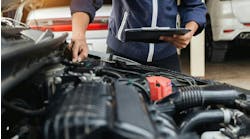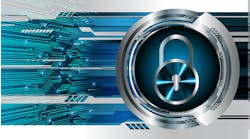At first look, it appeared to have been a very nasty accident. When the tow truck finally dragged the 2015 Dodge Challenger out of the swale, it was obvious that the vehicle sustained substantial damage to the trunk/deck and both quarter panels. The second vehicle -- a modified pickup – had a few scratches and dents on its grille and front bumper. It was obvious who won the bout between the Challenger and the modified truck.
Back at the body shop, an evaluation and estimate were performed. The loss was below its value and much less than what appeared at first glance. Repairs were approved by the insurance company.
After repairs were completed, the vehicle was returned to the customer. But days later, the Dodge returned to the body shop with “intermittent” driveability issues, from “fishbiting”/surging to stalling at stop signs and lights, minutes after a cold start-up in open loop. The business verified its work: visual, electrical check and checking for any corresponding diagnostic trouble codes (DTC). All system checks passed. Obviously, the issue had nothing to do with the accident or subsequent bodywork; the repair was properly performed. Since the Challenger was still within a post-factory, original equipment manufacturer (OEM) warranty, it was off to the dealership for further evaluation.
Multiple visits to the dealership service department did not uncover the issue. With a “no codes, no problem” mindset, the service writer explained that the concern must be a fuel-related issue and recommended to use an OE “Top-Tier” fuel brand. But it was obvious after multiple fill-ups that it was not the solution. The “stumble-to-stall” situation went from intermittent to “annoying.” The owner considered trading in the Challenger.
A last-minute visit to a trusted repair facility saved the day. After explaining the situation, it was time for yet another investigative review. Performing all the prescribed, initial steps to diagnosing any issue — especially a phantom issue — should always start with verify the complaint, verify vehicle specifications, visual inspection (including an inspection mirror check-over in hard-to-observe areas of concern), verifying electrical integrity, checking for outstanding technical service bulletins (TSBs), and perform initial basic tests. And there is another diagnostic test that most miss to perform: pending, present, pass-occurred emission codes and counts-values.
On just about every scanner, there is an option on the screen on the tablet, laptop, or other device, a pass-through in front of every technician that can take their repair game from Division 2 to Division 1 play. It’s called generic OBD-II. Among the options, there are a couple of go-to services that should be reviewed before any formal repair recommendation.
We need to check for any calibration identification (CAL-ID) discrepancies, as an outdated code could be the basis of the issue. But how do we locate these programming updates? Easy! Compare the most up-to-date related TSBs — located either on the manufacturer or NHTSA sites — versus the CAL-ID within the vehicle’s Mode$09 platform. If there is an update, this calibration must be installed before continuing our vehicle driveability diagnosis. And, of course, the procedure to diagnose the vehicle needs to start, again, at square-one.
Please take note: Do not install non-associated calibration updates into the vehicle. Transfer those only related to the issue per the TSB. First, you should be charging the customer for each CAL-ID update – not for the one-time, mass data dump, which means to leave the HVAC update for when the vehicle comes into the shop with an issue related to the TSB-to-CAL-ID update. Concentrate on the here-and-now. And that’s the “stumble-to-stall” at this junction.
Other, helpful content: Mode$09 includes calibration verification number (CVN) software authentication and emission performance for both gasoline and diesel applications, including but not limited to:
- Oxygen sensors
- Evaporative and EGR
- Air systems and secondary O2
- Variable valve timing values
- NOx particulate filter (both gasoline and Diesel)
- Turbo boost pressure and control
- Fuel system delivery
- Spark/ignition systems
- Compression ignition
After re-reviewing the system, another generic OBD2 must-visit click is Mode$06. This option is considered the emissions “engineering-side” of the data pack within the ECU. This data is usually presented in hexadecimal, those nonsensical-looking numbers, letters, and symbols mixture. The test identification (TID) designation (including message identification, or MID; parameter identification, or PID; failure mode identification, or FMI; subsystem identification, or SID) labels can be found on the manufacturer’s site via OEM1Stop or NASTF link. The more advanced scanners will give a clear explanation of the specific emission designation.
In this application, the TID designation was defined as a purge solenoid issue (Fig. 1, 2), with a pending designation, no fail, no permanent-current code.
So, it’s possible that this pending code is causing our customer’s complaint. But before going forward, an evaluation of what serves the customer best when it comes to continuing our diagnosis.
There are two schools of thought approaching this issue; the first is to replace the part and retest, a popular dealership route. But since this was an independent repair shop — and testing with a known-good “free” part is not an option — a deeper-dive was in order before condemning the purge valve. Now, there is always a reason for any electromechanical failure. And replacing parts based on a pending or failed code is not the answer, so backtracking from the suspect part/issue and performing a check associated to the source, the fuel tank/canister and associated sensors and valves (Fig. 3) is best practice. In this case, the suspect purge solenoid, located next to the intake manifold, is where we start.
Confirming proper voltage and ground at the unit/pigtail (voltage drop) – and verifying OE resistance values at the solenoid (in this case, manufacturer specs at 3.0 ohms), it was time for the vehicle to complete the OEM-programmed EVAP cycle, which it passed. Next, most qualified scan tools will allow for the bidirectional control of the EVAP systems to activate the purge solenoid “on.” There was no issue there, or at the ECU and manifold integrity. So, it was time to backtrack to the EVAP charcoal cannister (Fig. 4).
The purge solenoid vapor line heading toward the canister is the next check in relation to the EVAP map: fuel tank/cap, inlet check valve (ICV), grade vent valve (GVV), multifunction control valve (MFCV), tank pressure sensor (FTPS), ESIM (evaporative system integrity monitor), fresh air inlet (FAI). Checking the purge tube – or any vacuum line – integrity has multiple schools of thought: dye injected into the system, “smoke” test, and the practice of coating the outer tube with baby powder or cornstarch.
Making sure the ambient air temperature standards are within OEM specifications (for this Challenger, between 40° to 95°F range), repeat the manufacturer’s drive cycle test. Afterward, use a thermal imager to help us see degree variations on the plastic components. An increase within a specific area of the plastic component would suggest an issue. The powder residue would be a second verification of the failed part, as it would collect in the area where scuffed/flawed; reveal the flaw. If a fault line was detected, replacement would be in order. And that was the issue in this case. It was determined when the tow truck pulled the vehicle out of the swale, something had “hooked” itself onto the line and stressed it enough to the point that it “cracked” but did not break its anchor on either the purge solenoid or cannister.
The purge solenoid vapor line was replaced, and the repair (Fig. 5) was verified to have corrected the issue. The vehicle was released back to the customer without further incident.
That’s the magic of Mode$06. And there are eight other valuable modes within the generic side of the scanner, thanks to SAE J1979, OBD-2 standards:
- Mode$01: Current data available
- Mode$02: Freeze frame data
- Mode$03: Stored diagnostic codes
- Mode$04: Clear-all stored diagnostic codes and values
- Mode$05: Other system monitors (non-CAN bus, only)
- (Mentioned) Mode$06: Test results, monitors (CAN bus, only)
- Mode$07: Diagnostic trouble codes (DTC) for current/last drive cycle
- Mode$08: On-board components and systems
- (Mentioned) Mode$09: On-board vehicle coding information and counters
Then, there’s the latest mode to come to the party: Mode$0A – pronounced “Mode 10.” This mode retains the stored Mode$03 DTC in memory until the system has performed a complete monitor test. A history code can remain in Mode$0A file up to 400-days in 2012 and newer vehicles. Only after the affected module(s) have verified the repair via onboard system tests will the code disappear from the Mode$0A frame. There are no exceptions, including taking the vehicle “offline” by removing its 12VDC “keep-alive” source, or another tactic: touching independent, non-powered terminal ends together for an end-to-end reset. That doesn’t erase the Mode$0A data.
Will our Challenger retain the emission code that drove us to testing and ultimate replacement of the purge solenoid vapor line? No! And why? The code was only pending and not permanent. And pending codes are not part of the Mode$0A equation.
There are more standardized services for specific manufacturers per SAE J2190. For example, General Motors and Ford have 22 services – or modes – while Toyota hosts 21. These include alternative fueled vehicle platforms.
And Mode$07 -- diagnostic trouble codes (DTC) for the current/last drive cycle -- is not to be confused with Mode$0A. Like our Challenger, the relevance of Mode$07 is a requested emission and/or emission related present DTC or last completed driving cycle that allows “pending” code(s) to be detected during or the last drive cycle, as well. It is normally used to confirm the code is no longer present, post-repair.
Generic OBD2 will complement all other testing modes – including digital oscilloscope mapping – but knowing your scanners’ (as one does not “fix” all) capabilities is key to an effective, one-and-done diagnosis and repair. Be your customers’ hero – like the Dodge Challenger’s go-to shop – and master the capabilities of this diagnostic mode topology available on just about every scanner manufactured today.
*Verify OEM standards before applying smoke to emission components; certain equipment may void warranty.



